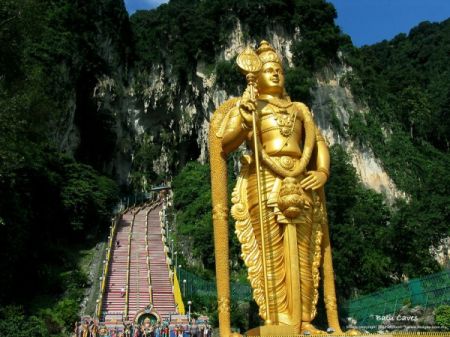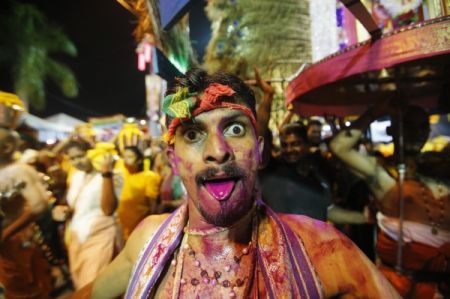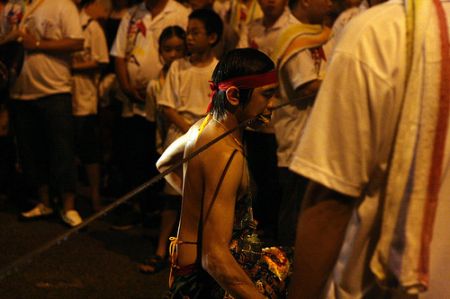
Just a few days ago, Malaysians observed one of Malaysia’s most cultural festival. Thaipusam is celebrated mostly by the Tamil and Chetty community on the full moon in the Tamil month of Thai. Surprisingly, the largest Thaipusam celebration is not in India but Malaysia. Singapore, Thailand and Myanmar also observe this celebration, but nothing beats the annual estimated two million crowd in Batu Caves or Batu Malai in Tamil which means Stone Mountain, the word Batu being of Malay origin. Comparably the crowd at Tanni Malai in Penang which means Water Mountain has been a competitor.
The word Thaipusam is a combination of the name of the month, Thai, and the name of a star, Pusam. This particular star is at its highest point during the festival. The festival commemorates the occasion when Parvati the Hindu Mother Goddess (note that the Malay term Ibu Pertiwi has its roots in this) gave Murugan a vel or spear so that he could destroy the evil demon Soorapadman. Also note the popular chanting for Thaipusam is “Murugan’ku arogara!” received with a thunderous “vel vel vetri vel”, the chant means Murugan has received an “anugerah” an award which is the vel, the victorious vel. Also note this is why Thaipusam procession of the vel begins at the Seri Maha Mariaman (Parvati) temple heading to Batu Caves (Murugan) temple.
Murugan is a deity especially for the Tamils. Also known as Skanda, he is considered the protector god of the Tamils. Due to these circumstances, Hindu’s besides the Tamils rarely recognize this deity. However today Murugan is not only worshiped by the Tamils, in Malaysia many Chinese, and Europeans join the pilgrimage too. Observing the cross culture, one would notice that many Taoist deities are the Chinese version of Hindu gods.
It is somewhat fascinating to see Malay police officers standing guard at Thaipusam celebrations, making sure people are safe. It is a rare occasion where Malaysian Indians interact closely with the Royal Malaysian Police without any threat of violence. The Malay community usually stays away from Thaipusam celebration for many believe that the devotees are possessed by evil spirits and due to fundamental Islamic teachings that forbids participation in religious practices of non-Muslims.
Another particularly interesting observation at Thaipusam is the trance like state many of the pilgrims were in. Some pilgrims appeal to spirits of demi-gods to help with the pain defying acts, some Hindus disapprove of such practices. Some say that even demonic spirits would partake in the pilgrimage; however this is nothing out of the ordinary as Hindus believe even demons have the right for penance and spiritual awakening.

Some of the more popular trances are of the Madurai Veeran deity, a guardian warrior demi-god of the poor, often spotting a turban, the frightening Kali deity with long hair, protruding tongue and wearing black or red skirts, and the epic monkey god Hanuman usually the pilgrim would carry a mace and depict mild monkey like movements.

Some Chinese pilgrims call upon the Nine Emperor gods to help with the Thaipusam pilgrimage. The Nine Emperor gods Festival is very similar to Thaipusam and is vastly celebrated in Penang on the eve of the 9th Lunar month. The term “mah song” used in the festival describes people who invite the spirits of gods to possess their bodies. Mah means horse in Thai, and the term “mah song” refers to how the spirits of the gods use the bodies of people as a vehicle, like riding a horse. The “mah song” tradition in The Nine Emperor gods’ festival is believed to have been adopted from Thaipusam. The term also accurately describes what goes on in the Malay dance ritual Kuda Kepang. The ritual had strong links with spirit possession and often dancers went into a trance-like state. However with the Islamisation of Malaysia, the dance now generally refers to a tale of nine Javanese men who spread Islam in Java, Indonesia.
It is very interesting to note that the celebration of Thaipusam in Penang is a little more unique then the rest. In Penang, Thaipusam celebration is started off by the Chettiar community in a ritual known as Chetty Pusam. The Chettiars are a distinctive group of Tamil people found mainly in Penang, Malacca and Singapore, they are also known as the Indian Peranakans.
[youtube]W9pjp7vSVNM[/youtube]
Like the Peranakans, the Chetties speak a Malay patois, which is mixed with many Tamil words. Many of the Chitty are unable to communicate in Tamil fluently. It would make sense to give the Chettiars bumiputera status as they have been around since the 1500’s.Chetty Pusam is slightly unusual as all of the Chetties would carry peacock kavadis and they avoid the body piercing and pain defying acts. Usually the Chetty Pusam entourage will include the flag of victory, musicians and trumpeters.
Batu Caves was promoted as a place of worship by the late K. Thamboosamy Pillai, an Indian trader in 1890. He was inspired by the ‘vel’-shaped entrance of the main cave and was inspired to dedicate a temple to the deity Murugan. Home to the world’s tallest statue of Murugan (some Malay youths mischievously refer to it as Ultraman Batu), it has become the number one focal point for Thaipusam celebration in the world. Batu Caves has transformed from a small mountain top temple to a Hindu religious complex hosting various Hindu temples of major Hindu deities attracting over 2 million visitors on Thaipusam day. It is now a major source of tourist attraction in Malaysia.
Of course the story of Thaipusam at Batu Caves would not be complete without the Malay folklore of Si Tanggang Anak Derhaka* (Tanggang the rebellious son). The folklore has it that Tanggang was cursed by his mother when he returned from abroad and refused to recognize his poor mother. Urban legend has it that he then turned into stone at Batu Caves as a result of the mother’s heartfelt curse, hence the statue in the cave. Coincidence so has it that Murugan is also known to be rebellious towards his parents Sivan, Parvati and brother Ganesha. It is believed that Murugan left the family and made the mountain tops his new abode at an early age due to some family miss understandings.
Batu Caves is evidence to the religious tolerance we Malaysians practice. Thaipusam has emerged as one of the biggest religious festivals in Malaysia. It is a public holiday in several states, and will continue to be part and parcel of Malaysia’s unique multicultural identity.
* For those who are interested, the folklore was first recorded in 1900 in a book published by The Macmillan Company : New York, titled Malay Magic written by Walter William Skeat as Charitra Megat Sajobang.
** The Malay version of this article can be found at Prisma .

Hello, Chettiars and Chettys are two vastly different communities. The celebration in Penang is by the Chettiars who hail from Chettinad in India. They are pure Indians and speak Tamil. They do not speak in any other language. They built these temples and carry out this special Thaipusam in Penang, Singapore, etc. They have settled down in Malaysia over the years. The Chettys, however, are a community in Malacca with an Indian mixed Malay identity. The men from India came to Malaysia and married local Malay woman making the community known as Chettys. Chettiar men, on the other hand, came from Tamilnadu, India and did money lending and business in SE Asia. So, Chettys and Chettiars are TWO very different communities with NO similar characteristics or culture. Please get your facts right before writing/posting because it may give a false understanding to readers. Hope you edit the article where necessary.
Chetty n Chitty – Get your Facts Right – Vast Difference !
Nice!